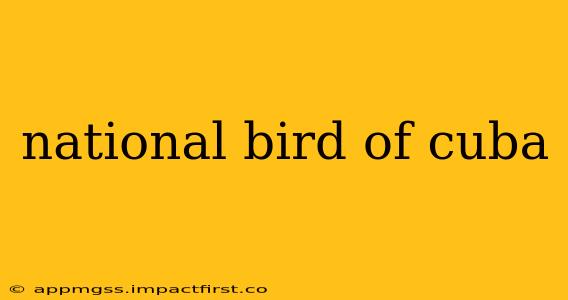Cuba, a vibrant island nation steeped in history and culture, boasts a rich biodiversity. Among its many natural treasures, one stands out as a potent symbol of national pride: the Cuban Trogon ( Priotelus temnurus). This strikingly beautiful bird, with its iridescent plumage and captivating presence, is the official national bird of Cuba. But what makes the Cuban Trogon so special, and why was it chosen to represent this Caribbean island nation?
What Makes the Cuban Trogon Unique?
The Cuban Trogon is a medium-sized bird, easily recognizable by its vibrant plumage. Males display an emerald green back, a bright red breast, and a striking yellow belly. Their tails are long and black, adding to their elegant silhouette. Females, while slightly less vibrant, still boast a beautiful green back and a rich chestnut breast. This striking color contrast makes them quite unmistakable in their native habitat. Their beauty is only enhanced by their gentle, melodious calls, often heard echoing through the Cuban forests.
Beyond their aesthetic appeal, Cuban Trogons are important indicators of forest health. Their presence signals a thriving and diverse ecosystem. Their preference for undisturbed, mature forests highlights the importance of conservation efforts to protect their habitat.
Why Was the Cuban Trogon Chosen as the National Bird?
The selection of the Cuban Trogon as the national bird reflects a deep connection between the Cuban people and their natural heritage. Its stunning beauty, unique characteristics, and restricted habitat make it an ideal symbol of the nation's identity and the importance of environmental protection. Unlike some other national birds chosen purely for their symbolism, the Cuban Trogon's selection underscores Cuba's commitment to biodiversity and its rich natural resources.
Where Can You See Cuban Trogons?
Cuban Trogons are endemic to Cuba, meaning they are found nowhere else in the world. They inhabit a variety of forest types across the island, from mountainous regions to lower elevations. While not always easy to spot, their distinctive calls and vibrant colors make them a sought-after sight for birdwatchers and nature enthusiasts visiting Cuba. Observing these magnificent birds in their natural habitat provides a truly unforgettable experience, further cementing their significance as a national symbol.
What are some other important birds in Cuba?
Cuba's diverse ecosystems support a variety of bird species. While the Cuban Trogon holds a special place as the national bird, other notable species include the tody, known for its bright green plumage and short, stubby beak, the Cuban parrot, a colorful and intelligent species, and various species of hummingbirds, famed for their dazzling aerial displays. These birds, along with many others, contribute to the rich avian biodiversity of the island.
Are there any threats to the Cuban Trogon population?
Like many species, the Cuban Trogon faces threats to its survival. Habitat loss due to deforestation and agricultural expansion poses a significant challenge. Furthermore, climate change and its impacts on the island's ecosystem also present concerns for the long-term health of the population. Conservation efforts are crucial to ensuring the continued survival of this iconic bird and its habitat.
What is being done to protect the Cuban Trogon?
Various conservation initiatives are underway to protect the Cuban Trogon and its habitat. These initiatives often focus on protecting and restoring key forest areas, promoting sustainable land management practices, and raising public awareness about the importance of conservation. By understanding and addressing the threats to their habitat, conservationists and researchers actively strive to preserve this valuable and beautiful species for future generations.
The Cuban Trogon stands as more than just a beautiful bird; it's a powerful symbol of Cuban national identity, highlighting the island's biodiversity and the importance of conservation. Its vibrant colors and enchanting song represent the beauty and richness of Cuba's natural heritage, a legacy that deserves to be cherished and protected.
